The type of protection by encapsulation (Ex “m”) is based on the principle of segregating an explosive atmosphere that may be present in the installation location, in the form of flammable gases or combustible dust, from internal parts of “Ex” components or equipment that could represent an ignition source.
The type of protection Ex “m” means that parts that are capable of causing an ignition of an explosive atmosphere by sparking or heating are completely “encapsulated” in a compound or resin or by means of a non-metallic enclosure, with adhesion, so as to prevent the ignition of an explosive atmosphere of flammable gases or combustible dust layer that may be present in the installation, when the Ex “m” equipment is under operating conditions.
.
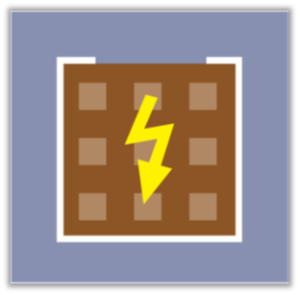
Examples of industrial “Ex” equipment for installation or use in hazardous areas that use or incorporate the type of protection by encapsulation Ex “m”, which is generally combined with other types of “Ex” protection, are: solenoids, sensing instruments, inductive, capacitive, and magnetic sensors, drivers for luminaires with LED lamps, hand-held instruments, portable flashlights, printed circuit boards, and components used in the manufacture of “Ex” smartphones or tablets.
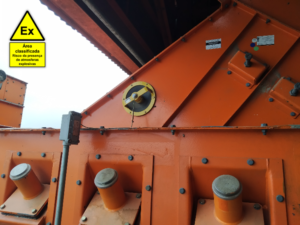
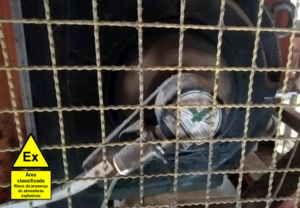
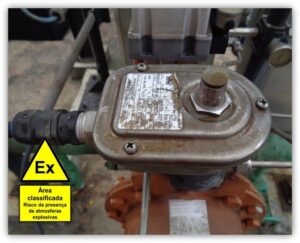
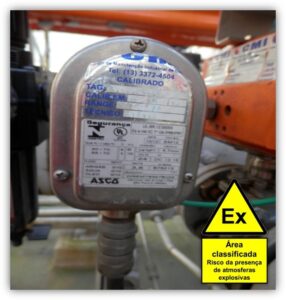
Depending on the manufacturing characteristics of Ex “m” encapsulated devices, they can provide all applicable protection levels for installations in underground coal mine areas, classified areas containing flammable gases, or classified areas containing combustible dust.
- Protection level “ma” (EPL Ma, Ga or Da)
- Protection level ““mb”” (EPL Mb, Gb, or Db)
- Protection level ““mc”” (EPL Gc or Dc)
This kind of “flexibility” of protection levels means that Ex “m” devices can be installed in all types of hazardous areas, depending on the EPL provided, making their application very “comprehensive”.
It was published by ABNT (Brazilian Technical Norms Association) in 2020, the fourth edition of the adopted Brazilian Technical Standard ABNT NBR IEC 60079-18: Explosive atmospheres – Part 18: Equipment protection by encapsulation “m”.
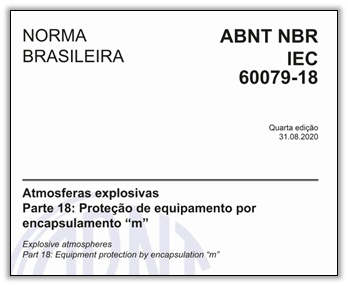
This Part of the adopted Brazilian Technical Standard Series ABNT NBR IEC 60079 (Explosive Atmospheres) presents specific requirements for construction, testing and marking of electrical equipment, parts of electrical equipment and “Ex” components with the type of protection by encapsulation Ex “m”, with nominal voltage below 11 kV, intended for use in explosive atmospheres of flammable gases (Groups IIA / IIB / IIC) or combustible dust (Groups IIIA / IIIB / IIIC).
According to the adopted Brazilian Technical Standard ABNT NBR IEC 60079-18, the specification of the encapsulation compound, to be submitted by the Ex “m” equipment manufacturer, during the certification process, shall include the following information:
- The name and address of the manufacturer of the compound
- The exact and complete reference of the encapsulation material and, if applicable, the percentage of filler and any other additives, the mixing ratio and the type of designation
- Surface treatment of the compounds, e.g., varnishing if applicable
- Requirements for pre-treatment of the component to achieve proper adhesion of the compound to a component, e.g., by cleaning or pickling if applicable
- The dielectric strength, in accordance with the requirements of Noma IEC 60243-1 (Electrical strength of insulating material – Test methods – Part 1: Tests at power frequencies), at the maximum service temperature of the composite, determined in accordance with the maximum temperature test procedure, presented in ABNT NBR IEC 60079-18, under normal operation or fault condition.
- The temperature range of the compounds, including the maximum continuous operating temperature (COT – Continuous Operating Temperature) and the minimum continuous operating temperature
- In the case of Ex “m” equipment, where the compound is an external part of the enclosure, the TI (Temperature Index) value must be reported, as defined in ABNT NBR IEC 60079-0. As an alternative to TI, the relative thermal index (mechanical RTI) can be determined according to ANSI/UL 746B Standard (Polymeric materials – Long-term property evaluations)
- The color of the compound used for the test specimen, where the specification of the compound may be influenced by the color change
- The thermal conductivity, in the case of using the “alternative” test method indicated in the Section “temperature of the compound” of the adopted Brazilian Technical Standard ABNT NBR IEC 60079-18. In this “alternative” method, the determination of the temperature of the hottest component in normal operation can be made by calculation, by the manufacturer’s specification or by a test of the component under the intended conditions of application, before the encapsulation of the component, if the thermal conductivity of the compound is higher than that of the air
The service temperature of the compound in Ex “m” equipment shall be determined according to the test procedures indicated in the Brazilian Technical Standard adopted ABNT NBR IEC 60079-0 (General Requirements for “Ex” equipment). This temperature cannot exceed the value of the maximum Continuous Operating Temperature (COT) of the encapsulating compound. The maximum surface temperature of the Ex “m” equipment shall be determined in accordance with the requirements indicated in Standard ABNT NBR IEC 60079‑0, under normal operation and under fault conditions, as specified in the “Fault Determination” Section of Standard ABNT NBR IEC 60079-18. Equipment with Ex “m” type of protection shall be protected so that the “m” encapsulation is not affected under the specified fault conditions that may occur.
From the construction point of view, when the encapsulation compound forms the external part of the Ex “m” equipment enclosures, the enclosure shall meet the requirements of the ABNT NBR IEC 60079-0 Standard for non-metallic enclosures and non-metallic parts of enclosures. If the surface of the encapsulation compound is totally or partially involved by an enclosure and this enclosure is part of the Ex “m” protection type, the enclosure or parts of the enclosure shall comply with the requirements for enclosures of the ABNT NBR IEC 60079-0 Standard (General requirements for “Ex” equipment).
If “specific” installation measures are required, this information shall be presented by the manufacturers to the end users of the Ex “m” products, in order to meet the requirements of the Brazilian Standard ABNT NBR IEC 60079-18. For example, an additional mechanical protection can be required to protect the Ex “m” equipment from a direct impact. In these cases, the number of the certificate of conformity for the Ex “m” equipment shall include the Suffix “X”, in accordance with the marking requirements of the Brazilian Standard ABNT NBR IEC 60079-0, and the specific installation conditions to be included in the certificate shall detail the precautions needed by end users to meet this “specific” installation requirement.
In the Ex “m” equipment some components can be considered as “not subject to fail”. Components or arrangements of components regarded as not subject to certain failure modes are determined in the adopted Brazilian Technical Standard ABNT NBR IEC 60079-11 (Type of protection by intrinsic safety Ex “i”).
For protection levels “ma” and “mb” the following components shall be considered “not subject to fail”, if they are encapsulated in accordance with the requirements of the Brazilian Standard ABNT NBR IEC 60079-18, considering also that they are suitable for the service temperature and if they are not operated at more than 2/3 of their rated voltage, rated current or rated power related to the nominal data of the device, the mounting conditions and the specified temperature range:
- Resistors
- Coils with spiral windings with a single layer of turns
- Plastic film capacitors
- Paper-film capacitors
- Ceramic film capacitors
- Semiconductors
- Semiconductor devices used as “protection devices”, which are specified in the ABNT NBR IEC 60079-18 Standard
- Resistors used as “protection devices”, if they meet the “current limiting resistors” requirements of the Brazilian Standard ABNT NBR IEC 60079-11 (Ex “i”), for protection levels “ia” or “ib”.
For protection levels “ma” and “mb”, the windings or coils that are used in the manufacturing of Ex “m” equipment, which meet the requirements of the adopted Brazilian Technical Standard ABNT NBR IEC 60079-7 (Equipment protection by increased safety – Ex “e”), including the windings manufactured with wires with diameters smaller than 0.25 mm, shall be considered “not subject to fail”, that is, “not subject to failure”, if these windings or coils are encapsulated in accordance with the requirements of Standard ABNT NBR IEC 60079-18.
The Brazilian Standard ABNT NBR IEC 60079-18 also presents the minimum thicknesses required for the encapsulation compound with respect to the free surfaces of the Ex “m” equipment, with respect to metal enclosures and for non-current conducting parts that are protected within the encapsulation compound. The ABNT NBR IEC 60079-18 Standard defines the minimum thicknesses of the compound, depending on the free surfaces of the Ex “m” equipment and also whether the outer casing is metallic or non-metallic. The ABNT NBR IEC 60079-18 Standard also defines the minimum separation distances for multilayer printed circuit boards that are protected by the encapsulation compound.
In cases of Ex “m” equipment that incorporate sparking capable switching contacts, as for example in “Ex” push buttons containing contacts for control circuits or for remote signaling circuits, these sparking contacts shall have an “additional” enclosure. In these cases, the ABNT NBR IEC 60079-18 standard draws attention to the risks of improper ingress of encapsulating compound into the interior of this “additional” enclosure during the encapsulation process, which can interfere with or impair the operation or function of the sparking contacts.
For these sparking or switching contacts, the voltage and current ratings must be less than or equal to 60 V and 6 A for equipment encapsulated at protection level Ex “ma” (EPL Ga/Da). This “additional” enclosure must be made of inorganic material in cases where the switching current exceeds 2/3 of the rated current specified by the spark-gap contact manufacturer. For encapsulated devices with protection level Ex “mb” (EPL Gb/Db), the additional enclosure must be made of inorganic material, if the switching current exceeds 2/3 of the nominal value of the current specified by the spark gap manufacturer or if the current exceeds 6 A.
In cases of Ex “m” equipment containing built-in accumulators or batteries, for protection level “ma” and “mb”, the battery charging circuits shall be fully specified as part of the Ex “m” equipment. In these cases, the charging system for the batteries or accumulators must be designed so that:
- With a fault condition of the battery charging system, the charging voltage and current cannot exceed the limits specified by the battery manufacturer; or
- If, during the charging process of the accumulators or batteries, it is possible that the limit values for the accumulator voltage or charging current specified by the manufacturer may be exceeded, a separate safety protection device (such as a fuse or a thermostat) shall be included in the Ex “m” equipment so that minimize the possibility of flammable gas release from the Ex “m” equipment and also so that the maximum temperature values of the accumulator reported by the manufacturer are not exceeded during the charging process.
Regarding the tests through which the Ex “m” equipment must be submitted in the certification process; the following type tests (laboratory tests performed in prototypes) and routine tests (tests performed in the products of the manufacturing line) are specified in the Brazilian adopted Technical Standard ABNT NBR IEC 60079-18:
TYPE tests for Ex “m” equipment:
- Encapsulation compound tests: water absorption and dielectric strength
- Equipment tests: Maximum temperature, thermal resistance to heat and cold, dielectric strength, cable pull, pressure tests, thermal protection device testing with reset, built-in protection devices,
ROTINE testing for Ex “m” equipment:
- Visual inspections for absence of cracks, damage to enclosures, exposure of encapsulated parts, flaking, shrinkage, swelling, decay, lack of adhesion or softening
- Dielectric strength
The terminals of equipment protected by encapsulation (Ex “m”) are often individually protected by the Ex “e” type of protection (increased safety), making the equipment protected by encapsulation have a combination of protection types applied by the manufacturers to the respective products, such as Ex eb mb IIC T6 Gb.
Among the benefits provided by the application of resin encapsulated devices (Ex “m”), incorporating or not the combination of protection with terminal blocks in increased safety (Ex “e”), the following can be mentioned:
- The same equipment protected by encapsulation (Ex “m”) normally satisfies both the requirements for flammable gases (EPL Ga, Gb or Gc) and combustible dusts (EPL Da, Db or Dc)
- Careful application of the three levels of encapsulation protection (ma, mb and mc) ensures that suitable Ex “m” equipment is used for each risk level. Usually “ma” equipment is applied in Zone 0, Zone 1, Zone 2, Zone 20, Zone 21, or Zone 22, “mb” equipment is applied in Zone 1, Zone 2, Zone 21 or Zone 22 and “mc” equipment is applied in Zone 2 or Zone 22
- Encapsulated Ex “m” equipment is normally certified for Group IIC and Group IIIC hazardous areas, which ensures that this equipment can also be installed in all types of hazardous areas containing flammable gases (Groups IIA, IIB and IIC) or combustible dust (Groups IIIA, IIIB and IIIC), ensuring the benefit of standardization of Ex “m” equipment in all types of area classification
- The Ex “m” type of protection also provides, when compared with other types of “Ex” protection, greater facilities for assembly, inspection and maintenance services in classified areas containing flammable gases or combustible dusts, during the period of plant operation, allowing “conventional” assembly and maintenance procedures to be used, without the need to apply complex field service procedures in explosive atmospheres.
From the point of view of the Quality Management System (QMS), to be implemented by manufacturers of equipment and Ex “m” components, based on the adopted Brazilian Technical Standard ABNT NBR ISO 9001 (Quality management systems – Requirements), the adopted Brazilian Technical Standard ABNT NBR ISO/IEC 80079-34 (Explosive atmospheres – Part 34: Application of quality management systems for the of Ex products manufacture) presents specific requirements on this type of protection by encapsulation.
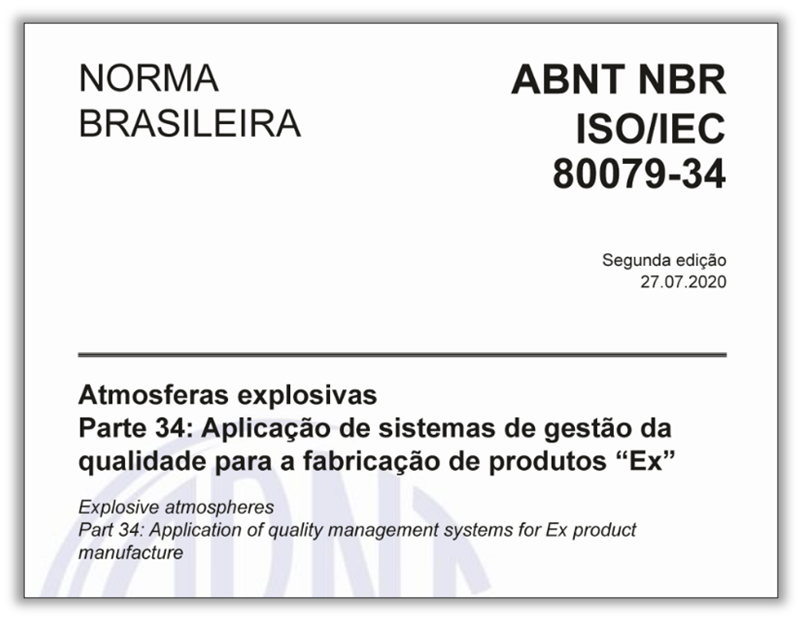
According to Standard ABNT NBR ISO/IEC 80079-34, under the point of view of documentation for the manufacture of Ex “m” products, it is recommended that the devices for thermal protections (for example, thermal fuses) are positioned and are of the specified type according to the certification drawings. From the point of view of routine tests and checks to be performed from manufacturers of Ex “m” products, it is recommended that all tests be documented, including visual verification and dielectric strength tests.
According to the ABNT NBR ISO/IEC 80079-34 Standard it is also recommended that the documented manufacturing procedures for Ex “m” equipment and components include the following information and requirements:
- Validity and storage of cements, resins, and components
- Compound preparation
- Surface preparation (degreasing, or equivalent method is required immediately prior to the encapsulation operation to ensure adequate adhesion of the product)
- Application, e.g., application instructions, absence of cavities (voids) and temperature conditions
- The curing process, including: the curing period, any relevant environmental factors, measures to ensure that the product is not manipulated during the curing period
- After curing, it is recommended that an inspection be performed on each encapsulated assembly. Depending on the nature and repeatability of the encapsulation process and the encapsulated assembly, this inspection can be performed, for example, using statistical techniques
Among the main technical changes that have been incorporated in the 2020 Edition of the adopted Brazilian Technical Standard ABNT NBR IEC 60079-18 (Type protection Ex “m”) compared to the previous edition, the following can be highlighted:
- Requirements for protection against inadmissible temperature and damage have been included for accumulators and batteries incorporated in Ex “m” equipment
- Requirements for accumulators or batteries incorporated in Ex “m” products have been modified and included
- F
- Requirements on protection against impermissible temperatures and damage to accumulators or batteries have been specified. For equipment with protection level “ma”, designed for EPL “Da”, the maximum surface temperature must be determined with the equipment mounted in accordance with the manufacturer’s instructions and surrounded on all available surfaces by a dust layer with a minimum thickness of 200 mm
It has been specified that the temperature rise during the testing of equipment should be a rather slow process. The final temperature should be considered to have been reached when the temperature rise rate does not exceed 1 K / 24 h.
The adopted Brazilian Technical Standards of the series ABNT NBR IEC 60079 (Explosive atmospheres) and ABNT NBR ISO 80079 (Ex” mechanical equipment) elaborated by the Study Commissions of the SCB 003:031 Subcommittee and published by ABNT are identical, in terms of technical content, structure and wording, without national technical deviations in relation to the respective IEC international standards, in accordance with requirements specified in ABNT DIRECTIVE 3 – Adoption of International Technical Documents.
The adopted Brazilian Technical Standards of the series ABNT NBR IEC 60079 (Explosive atmospheres) and ABNT NBR ISO 80079 (Ex” mechanical equipment) elaborated by the Study Commissions of the SCB 003:031 Subcommittee and published by ABNT are identical, in terms of technical content, structure and wording, without national technical deviations in relation to the respective IEC international standards, in accordance with requirements specified in ABNT DIRECTIVE 3 – Adoption of International Technical Documents.
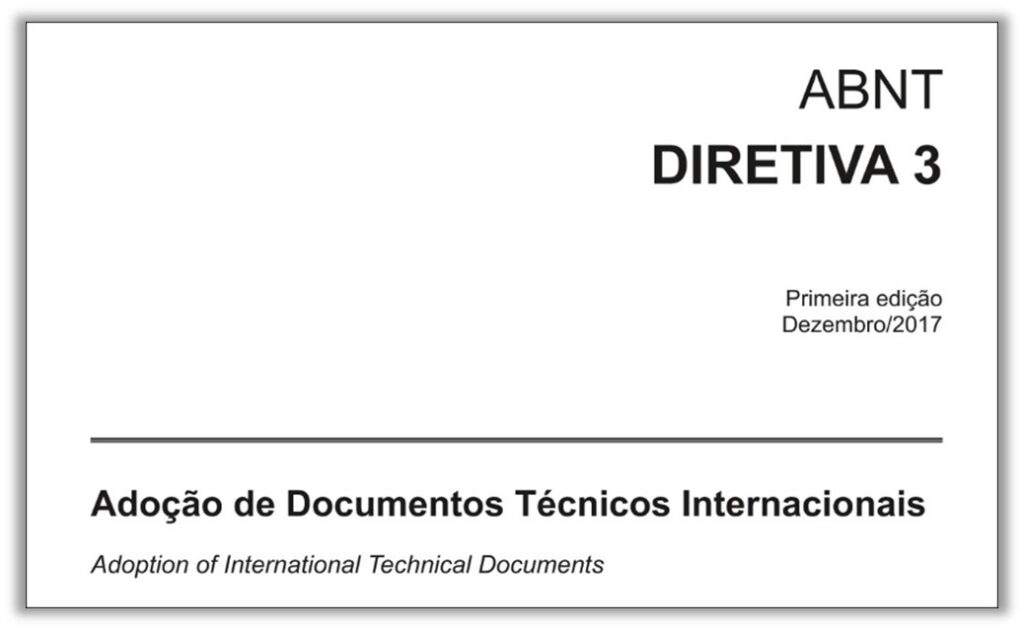
Following the trend and the world normative convergence of the IEC member countries, including Brazil, the national Technical Standards that involve the processes of conformity assessment of “Ex” service facilities, “Ex” personal competence and “Ex” electrical and mechanical equipment are adopted Standards, identical to the respective IEC international standards. This standardization policy aims to harmonize the National Standards with the international Standardization, in order to standardize the procedures for design, manufacturing, testing, marking, conformity assessment, installation, inspection, maintenance, repair and recovery of “Ex” equipment and personal competence.
Actions like these contribute to the integration of Brazilian Manufacturers, Test Laboratories, End User Companies, products and people Certification Bodies and Training Providers with the market and the international “Ex” community, as well as to the elevation of the levels of safety, health, environment, risk assessment, tests, quality, performance, reliability, service execution procedures and personal competences, related to the national “Ex” installations.
Considerations about equipment protected by encapsulation – Ex “m”
- The Ex “m” type of protection is internationally accepted, and there is a progressive acceptance of certificates of conformity with this type of “Ex” protection, making it increasingly widespread and applied in recent projects and developments in the chemical, petrochemical, oil & gas, food, pharmaceutical, mining, steel mill, and port industries, among others
- Encapsulation protected equipment can be installed in all places with the presence of classified areas, including underground coal mines (Group I), surface industries with the presence of flammable gases (Groups IIA / IIB / IIC) or installations with the presence of combustible dust (Groups IIIA / IIIB / IIIC), depending on their constructive characteristics, which are considered and evaluated during the certification processes
- Ex “m” equipment can be installed in any Zone including Zone 0, Zone 1, Zone 2, Zone 20, Zone 21 or Zone 22, according to the level of protection (EPL) provided (Ma, Mb, Ga, Gb, Gc, Da, Db, Dc), depending on their constructive characteristics, which are considered and evaluated during the certification processes
- Due to the benefits of flexibility and scope of installation, the type of protection by Ex “m” encapsulation can be adopted as “standardization” for various equipment of instrumentation or automation systems in classified areas, regardless of the characteristics of the installation site
- Despite the high safety levels provided by the Ex “m” equipment, in order to assure that this “Ex” equipment keeps presenting the protection and safety requirements for which it was manufactured and certified, there is the need to have a system of periodic inspections and maintenance, throughout the total life cycle in which these “Ex” instruments, equipment, components or devices remain installed in classified areas, throughout the years or decades of operation of the industrial plants
- The inspection and maintenance activities for Ex “m” equipment and installations can be considered one of the most important actions in the sense of reaching the required safety levels of these “Ex” installations. These activities can be considered as being the “heart” of an entire process of asset management and personnel management in facilities involving explosive atmospheres
- It is becoming more and more evident that the existence of a conformity assessment program for the certification of “Ex” instrumentation, automation, telecommunications, electrical or mechanical equipment is not enough to guarantee the high levels of safety required in these industrial facilities with explosive atmospheres containing flammable gases or combustible dust
- It can be verified that it is not enough that the Ex “m” equipment protected by encapsulation has been properly manufactured, tested in laboratories and certified, if the people do not have the proper training, knowledge, skills and qualifications for the execution activities or supervision of design, selection, technical specification, installation, assembly, inspection or maintenance of this Ex “m” equipment
- The encapsulation type of protection provides one of the highest levels of safety for installations in classified areas containing explosive atmospheres formed by flammable gases or combustible dusts. Consistently and defensibly, the Ex “m” protection type can be considered to be one of the safest and the least prone to human error or failure when compared to the other “Ex” protection types
- All “Ex” types of protection can be considered “safe”, but only if the respective “Ex” instrumentation, automation, telecommunications, electrical or mechanical equipment has been properly selected, installed, inspected, maintained, or repaired, throughout its total life cycle. For these reasons “Ex” instrumentation, automation, telecommunications and electrical equipment should be specified that provide SIMPLER field services from the point of view of the users and owners of the “Ex“ equipment, who are responsible for the safety of their installations
- In order that the equipment protected by Ex “m“ encapsulation can be properly designed, manufactured, specified, installed, inspected, maintained, and repaired, according to the Brazilian Technical Standards adopted from the ABNT NBR IEC 60079 Series – Part 14, Part 17, Part 18 and Part 19, there is the need for the people involved in these activities to have the proper competences for performing the functions for which they are responsible

Roberval Bulgarelli
Consultor Técnico sobre equipamentos e instalações em atmosferas explosivasMestrado em proteção de sistemas elétricos de potência (POLI/USP)
Membro de Comissões de Estudo do Subcomitê SCB 003:031 (Atmosferas explosivas) da ABNT/CB-003 (Eletricidade)
Membro de Grupos de Trabalho do TC 31 (Atmosferas explosivas), TC 95 (Relés de proteção) e do IECEx (Sistemas internacionais de certificação “Ex”) da IEC
Organizador do Livro “O ciclo total de vida das instalações em atmosferas explosivas”
